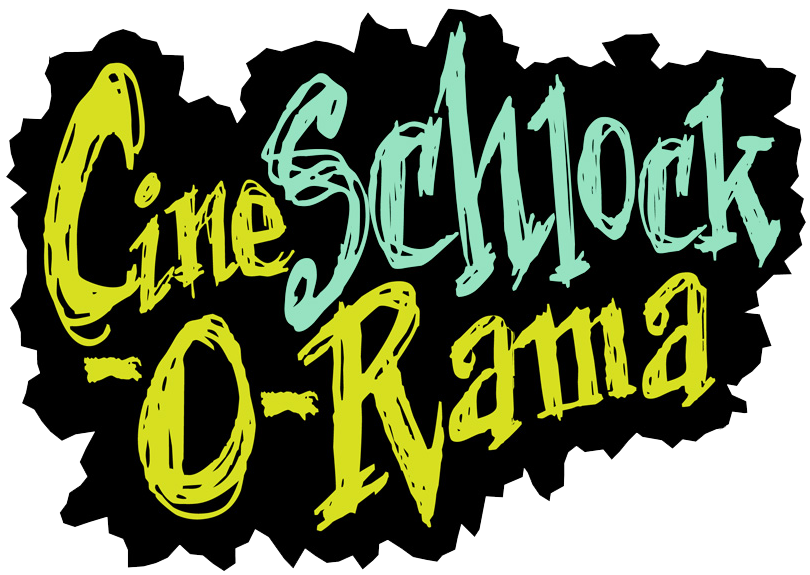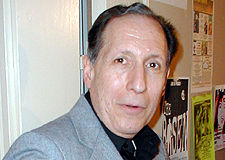
Secrets of B-Moviemaking
April 29, 2001
Sam Sherman was the close friend and collaborator of genre filmmaker Al Adamson for more than 25 years. Together they brought many outrageous B-pictures to the screen like Satan’s Sadists, I Spit On Your Corpse and Blazing Stewardesses. During an informal talk he gave at the Chiller Theatre Expo, Mr. Sherman shared his unique experience as a veteran exploitation producer. The following are excerpts from that discussion:
Always shoot on one better format than you can afford.
If you can afford Hi-8, get the money and get a DV camera. Rent it. Borrow it. Get it in the middle of the night. I’m not saying how. And when you’re comfortable in DV, then shoot in 16mm. Go up one more level. If you have a nice budget of $100,000, or whatever you have, and you’re shooting comfortably in 16mm, stretch your limits and go and shoot it in 35mm. Once you pay for blowing it up to 35mm the financial difference is gone. So, my feeling is to always stretch yourself to the next level, which is sometimes difficult to do, but it’s worth it in the end.
I found many times we sort of deficit financed a movie. We put a lot of money into it and we still had bills. But the sales came in and paid for it, because we had a better product. It’s sometimes worth the producer putting himself under a little more pressure to make the thing work.
Appreciate the value of Bolex cameras.
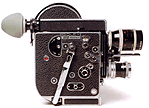 It’s the most wonderful piece of equipment, because for $300 you can buy a Bolex Reflex 16 and it’s capable of many different things. I wouldn’t shoot a sound film on it. But if you were shooting with a sound camera you could still do all your pickup shots and MOS silent scenes with your Bolex. It’s small, it’s crank wound and you can take it anywhere. In film we have what’s known as a registration pin which makes it very steady in the gate and a Bolex camera has a registration pin. People don’t generally know that. And you can blow it up to 35mm, which I’ve done, and it’s incredibly steady and sharp.
It’s the most wonderful piece of equipment, because for $300 you can buy a Bolex Reflex 16 and it’s capable of many different things. I wouldn’t shoot a sound film on it. But if you were shooting with a sound camera you could still do all your pickup shots and MOS silent scenes with your Bolex. It’s small, it’s crank wound and you can take it anywhere. In film we have what’s known as a registration pin which makes it very steady in the gate and a Bolex camera has a registration pin. People don’t generally know that. And you can blow it up to 35mm, which I’ve done, and it’s incredibly steady and sharp.
My advice to young filmmakers is for them to buy one of these cameras and shoot a silent film. Begin in film. Video is wonderful because you have image, sound and you can dump it into the computer. But the one thing against all that is you’re losing the tactile connection to film itself. You can hold up a one-foot strip of film and look at it and see the shot, you see the closeup. I call it the romance of film, as it’s more than just the storytelling process.
Remember that you want the audience to believe your story.
If it’s a story that’s horror, sci-fi, or something that doesn’t exist in reality, you’ll have a harder time making it than a little story about real people doing whatever they’re doing. Always try to make a simple story if you have a small budget. Don’t try and make a huge, huge thing with a lot of bad actors and a lot of extras that can’t act and can’t move and look into the camera, because it’s going to end up worthless. It’s better to have a small story with three to eight people who can all act. Tell it well. And that’s where the most important part of any film comes in — the script. The cheapest part of any film is typing paper, and today you have bits and bytes in the computer so there’s no cost. The story’s the whole thing. Get it to work. Get it believable. Have crisp dialogue.
I could stand up here in front of you and come up with a story that never existed and I could get you to follow it. And I don’t even know what I’m going to say. But I’m now going to tell you that I did hear yesterday that somebody who was in [this lecture hall] had a fatal disease. Some kind of bacterial contamination worse than the Ebola virus. And supposedly, this had spread throughout the room, and it was on several of the tables and chairs. Anybody who comes in contact with these tables is risking getting something that’s incurable. It just goes through the body and begins to turn you into some kind of green ooze. See what I’m saying? You just make these things up. There’s no production value involved. It’s your imagination. Your brain thinks about it, and you can do so much in a movie with just your mind.
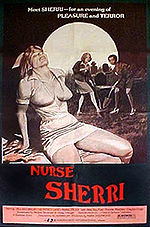 Nurse Sherri is one of those pictures. I was talking to Al Adamson on the phone and I said, "Al, we really want to do something a little different. We’ve made stewardess pictures. Roger Corman‘s made all these nurse pictures. Why don’t we do a nurse picture?" It was just a type of picture. I’d been impressed by a fairly good film called The Student Nurses that Stephanie Rothman had made. So I said to Al, "Go to see that. It’s pretty prototypical." He did and came up with a thing we were working on where these nurses had witnessed a bank robbery. I don’t know if that was in The Student Nurses, or if it was our idea, but we began writing this thing together over the telephone. Three hours a night on the phone. We’d always write scripts like that. But I finally said to him, "Let’s throw this away. I don’t want to do it. It’s too trite."
Nurse Sherri is one of those pictures. I was talking to Al Adamson on the phone and I said, "Al, we really want to do something a little different. We’ve made stewardess pictures. Roger Corman‘s made all these nurse pictures. Why don’t we do a nurse picture?" It was just a type of picture. I’d been impressed by a fairly good film called The Student Nurses that Stephanie Rothman had made. So I said to Al, "Go to see that. It’s pretty prototypical." He did and came up with a thing we were working on where these nurses had witnessed a bank robbery. I don’t know if that was in The Student Nurses, or if it was our idea, but we began writing this thing together over the telephone. Three hours a night on the phone. We’d always write scripts like that. But I finally said to him, "Let’s throw this away. I don’t want to do it. It’s too trite."
Well, around the same time a picture came out called Carrie. Just overnight — BAM! — a big, successful possession movie. And I said, "That’s what I want to do! A picture like Carrie, but I don’t want to throw the nurse angle away, or the sex. I still want to have the nurse, and the sex and the whole thing, plus the possession." So we started talking about it, and then I came up with an idea, I said, "How about if it involves a nurse, not someone who just happens to see a bank robbery. Let’s have it involved with her being a nurse who’s in an operation where a man is having open-heart surgery against his will and dies. Then his spirit possesses her and gets her to kill all the doctors who performed the operation." Now there’s a pretty good plot that came to me in just a blink of an eye. The idea was powerful and Nurse Sherri was a film that you couldn’t kill with a stick. It just kept playing. Even overseas. Every country bought it. We’re still selling it.
Always take credit for what you do.
When I started Independent-International Pictures, I was the founder of the company, I was the president, I did all these different things, but I never cared if my name was on the picture or not. I always thought that other people should have credit, but I never cared if I had any. I just wanted the finished film so I could get it booked into theaters. But, in time, you learn that people want to know who made different films. So I advise, if you make a film, if you write a film, if you contribute anything — even if you don’t get paid — insist on credit on the screen, on the print, on the advertising. Because that credit is your career. It’s a very important thing.
Don’t ever be afraid to say you don’t have money.
Don’t be so concerned about image, because the only thing that’s important is your film itself. Image means nothing. When we made Dracula vs. Frankenstein, I got sick from spending all day in the studio building and painting that laboratory. I did it by taking a truck and going to a little place in downtown L.A. that had surplus garbage. Real junk. I told them I was making a student film and that I needed some props. The guy there started trying to sell me different objects for $15 or $20 each. I said, "Wait a minute, this isn’t MGM. This is a little student film. For all this junk, I’ve got $50." Cash works very nicely on a picture. He asked me where I was parked and told me to bring my flat-bed truck around and said, "No problem. We’ll just fill it up." They loaded it with everything. Broken circuit boards. A piece of an antenna. But my favorite part was a green thing from a store that was a magic marker holder. I said, "You know, there’s something appealing to me about that. How many do you have of those?" And they threw on a bunch more. I took all this stuff over to Hollywood Stages and just dumped it on the soundstage. I sprayed the pen holders with aluminium paint and went ahead and nailed up two or three of them at the top of the set. And you’d be surprised, because after we added Ken Strickfaden‘s big hanging piece, the Jacob’s ladders and all that stuff — the pen holders still looked great. I thought that was a nice touch.
When hiring actors, see them, meet them, talk to them. Sign nobody over the telephone.
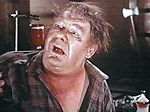 When trying to cast Dracula vs. Frankenstein, Al said, "We’ve got a great bargain! Two for the price of one: Lon Chaney Jr. (right) and J. Carrol Naish!" The one thing that I never said and Al never thought of was, "Why are we getting them at such a bargain?" We were so desperate to have names in our picture. People love Dracula vs. Frankenstein, but some of them hate it to, and they always talk about how horrible these big stars were. But I loved these people, and in some ways I’d rather have their memory, than have them look so decrepit in the film. Lon Chaney was dieing of cancer during the making of the movie.
When trying to cast Dracula vs. Frankenstein, Al said, "We’ve got a great bargain! Two for the price of one: Lon Chaney Jr. (right) and J. Carrol Naish!" The one thing that I never said and Al never thought of was, "Why are we getting them at such a bargain?" We were so desperate to have names in our picture. People love Dracula vs. Frankenstein, but some of them hate it to, and they always talk about how horrible these big stars were. But I loved these people, and in some ways I’d rather have their memory, than have them look so decrepit in the film. Lon Chaney was dieing of cancer during the making of the movie.
Don’t sell your pictures off.
The one thing that I’ve attempted to do over the years is hold on to the rights to all our pictures. It allows you to make distribution deals. If you own them, copyright them and keep your materials. And when you license them for say five years, make sure they come back to you. It’s very important. That’s your property.
Don’t think like a B-picture producer.
Don’t think, "I’m making a piece of junk." Think of yourself as making a project that’s a piece of entertainment. And I’ll say this proudly, that the films that Al Adamson and I made have been seen by more people than many major pictures. It’s hard to believe. There’s people who’ve seen some of these films on video, who never saw them in the theater, and they say, "Well, where did these crummy little pictures play?" How about 5,000 percentage engagements in theaters all over the United States. How about licenses to every major country in the world. How about sales to major television stations. We have had our low-budget films seen by more people, more times, than just about any other producers. I’m talking about films that we made for under $200,000 when comparable Roger Corman or A.I.P. pictures were $600,000 to $800,000. If you make it interesting, even if it’s a little rough around the edges, the people will like to see it. That’s the key to the whole thing.
